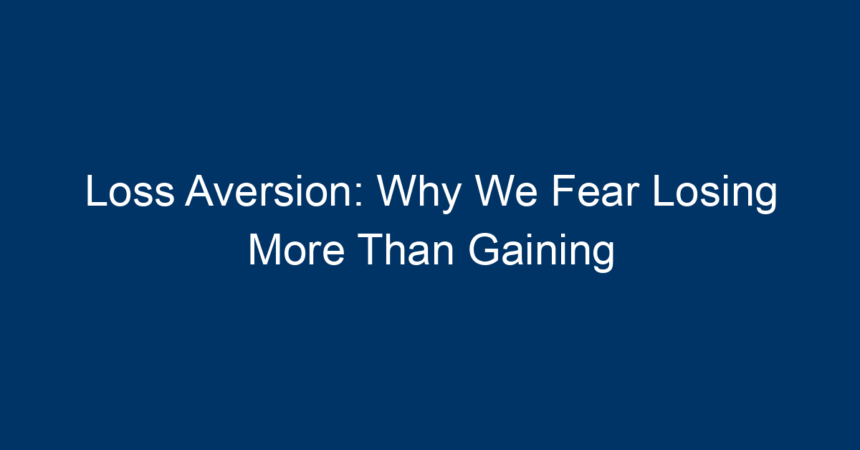Introduction
Have you ever hesitated to sell a stock after it has dropped in value, even when your gut tells you it’s the right decision? If so, you’re not alone. This powerful emotional response is known as loss aversion, a concept rooted deep in our psychology. Coined by psychologists Daniel Kahneman and Amos Tversky in their groundbreaking work on behavioral economics, loss aversion explains why we tend to fear losses more than we value equivalent gains. This article delves into the intricacies of loss aversion, explores its implications in various aspects of life, and offers actionable insights on how to manage its effects.
Understanding Loss Aversion
The Psychological Basis of Loss Aversion
Loss aversion is grounded in the idea that losses loom larger than gains. Research shows that the pain of losing $100 is more intense than the joy of gaining $100. This asymmetry affects how we make decisions, often leading us to avoid risks that may be beneficial.
The Origins of Loss Aversion
Kahneman and Tversky introduced the concept as part of their Prospect Theory, which describes how people choose between probabilistic alternatives that involve risk. They discovered that people make decisions based on perceived gains and losses rather than final outcomes. This has profound implications for investments, marketing, and personal finance.
The Impact of Loss Aversion on Decision-Making
In Finance and Investing
Investors are significantly influenced by loss aversion. Many hesitate to sell declining assets, hoping for recovery to avoid crystallizing losses. This often results in holding onto assets that continue to underperform, ultimately leading to bigger losses.
The Sunk Cost Fallacy
Linked to loss aversion is the sunk cost fallacy, where individuals stick with investments that are no longer viable due to the amount already invested. Understanding this fallacy is crucial for better financial decision-making. Rational investors should base their choices on future potential rather than past investments.
In Marketing and Business
Marketers exploit loss aversion by framing their offers to highlight what customers stand to lose rather than what they can gain. For example, limited-time offers often emphasize the risk of missing out, which can nudge consumers toward making a purchase.
The Power of Scarcity
Implementing strategies that create scarcity can trigger loss aversion. When customers perceive a product as limited, they fear losing the opportunity to acquire it, prompting faster purchasing decisions.
In Personal Relationships
Loss aversion can also impact our relationships. Fear of losing a partner or friend can lead to unhealthy behaviors, such as clinginess or jealousy. Understanding this emotional response can empower individuals to foster healthier, more balanced relationships.
Overcoming Loss Aversion: Strategies and Insights
1. Embrace the Right Mindset
Recognizing that loss aversion is a natural human instinct can help you cultivate a healthier mindset. Understand that losses are part of life and often pave the way for future gains. Accepting this reality can reduce the emotional weight of potential losses.
2. Reframe Your Perspective
Instead of fixating on what you might lose, focus on what you stand to gain. This shift in perspective can help mitigate the fear associated with loss aversion. For example, if you’re considering a career change, concentrate on the potential benefits of new opportunities rather than the fear of leaving a familiar job.
3. Limit Emotional Decision-Making
Make decisions based on logic rather than emotions. Establish criteria for making important choices and stick to them. For instance, when investing, set clear rules for when to sell based on performance metrics rather than emotional responses to market fluctuations.
4. Set Realistic Expectations
Setting realistic expectations can ease the intensity of loss aversion. Understand that losses are a part of any journey, whether in investments, business, or personal relationships. By preparing for potential setbacks, you reduce the emotional shock that often accompanies loss.
5. Create a Support System
Having a support network can provide the emotional resilience needed to counteract loss aversion. Whether it’s friends, family, or a mentor, discussing your fears and concerns can help you see situations more clearly and make better decisions.
Real-World Applications of Loss Aversion
Case Study: Behavioral Economics in Marketing
Consider a well-known campaign by a leading airline that framed price increases as a limited offer. By communicating that prices would rise in the near future, they positioned the loss of a lower fare as the primary motivator for customers. This strategy effectively played into loss aversion, prompting an increase in bookings.
Case Study: Investment Strategies
An investment firm noticed that many clients were stuck in poor-performing stocks due to loss aversion. To combat this, they launched a series of workshops educating clients on the importance of diversifying investments and avoiding emotional decision-making. As a result, many clients adjusted their portfolios, leading to greater overall satisfaction.
Case Study: Personal Development Programs
Personal development courses often teach techniques to manage fear and anxiety linked to loss aversion. By utilizing cognitive behavioral therapy (CBT) techniques, individuals learn to reframe their thoughts and focus on constructive outcomes rather than dwelling on potential losses.
Conclusion
Loss aversion is a fundamental part of human psychology that influences our decision-making across various aspects of life. By understanding this powerful bias, we can better navigate financial choices, marketing strategies, and personal relationships. Embracing a proactive attitude, reframing perspectives, and utilizing logical frameworks for decision-making can all help mitigate the negative effects of loss aversion.
Actionable Insights:
- Educate Yourself: Familiarize yourself with loss aversion and its impact on your decisions.
- Practice Mindfulness: Develop awareness of your emotions when faced with risk, and evaluate them objectively.
- Seek Professional Advice: When in doubt, consult a financial advisor or a trusted friend to gain a balanced perspective.
- Reassess Regularly: Periodically review your investments, career paths, and relationships to ensure they align with your long-term goals, rather than being anchored by past losses.
By implementing these strategies, you can transform your relationship with loss aversion into a constructive force in your life. Embrace the journey, learn from setbacks, and watch as new opportunities unfold.




